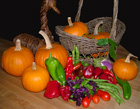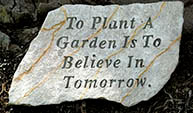![]()
How We Can Eat Our Landscapes?
What should a community do with its unused land? Plant food, of course.
Pam Warhurst, cofounder Incredible Edible, tells at the TEDSalon the story of how she and a growing team of volunteers came together to turn plots of unused land into communal vegetable gardens, and to change the narrative of food in their community.
Watch this Ted Talk video-click here.
In Sacramento, buying locally-sourced fruits and vegetables can be as simple as walking over to a neighbor's farm stand or a neighbor’s garden, thanks to the URBAN FARM ORDINANCE passed in 3-24-2015 by the Sacramento City Council. In a 6-1 vote, the city effectively opened the door to minifarms on private properties and in vacant lots that would be able to sell produce out of urban farm stands. This is a Win-Win for Sacramento! Read the Sacramento Bee article ...
This new era of self-reliance and sustainability needs your help to keep it growing by sharing with friends, family, neighbors and associates!
Locally Grown Organic Food
Making affordable, locally and regionally-grown organic food available to all, rich, middle-income and poor, must become a top priority for city and county governments across the nation.
Making the transition to organic food and farming stimulates the local economy, improves public health, sequesters enormous amount of climate destabilizing greenhouse gases, and protects the environment. As global warming intensifies, scientists warn that a continuation of current "business as usual" practices will lead to a catastrophic 8.6 degree Fahrenheit temperature rise by 2100. Our only hope is to make energy-efficient and climate-stabilizing organic food and farming the norm rather than just the green alternative.
Economic benefit of buying local food confirmed
P.K. Read | Food Tank
A new report from a team of economists proves that buying local food directly from farmers – whether at a farmers market or through a CSA program – does have lasting, measurable and positive impact on communities.
Implement the Precautionary Principle
Organic standards are a great example at the federal level of the precautionary principle in action. If this country valued human health and environmental protection, all US food would be organic, and industrial food production, with its pesticides, synthetic fertilizers, genetic engineering, nanotechnology, cloning and factory farms, would never be allowed because it has never been proven safe - and it never could be proven safe. While the precautionary principle has begun to be applied in Europe through the REACH legislation, it has never been put to use in the US at the federal level. (The epidemic of diet-related diseases in this country is proof that the precautionary principle hasn't been applied.)
At the local level, the precautionary principle could be used in decisions on zoning and land-use to make sure that risks to human health and the environment are fully explored.
Sustainable farming can feed the world?
Read the story about ...
Sacramento's 2007 front yard landscape ordinance!
Why organic produce ... worth the money
Commercial organic farms ... better fruit & soil
Disappearing Honeybee & Native Bee articles
READ MORE ARTICLES!
SUSTAINABLE URBAN GARDENS - THE BLOG!
http://sacgardens.blogspot.com
![]()
- more books - garden books




The Art of Simple Food - Alice Waters
Eating on the Wild Side - Jo Robinson
In Defense of Food:An Eater's Manifesto - M Pollan
Placer County Real Food Cookbook - Neft & Kenny
Check out our kids books, links & teaching resources





